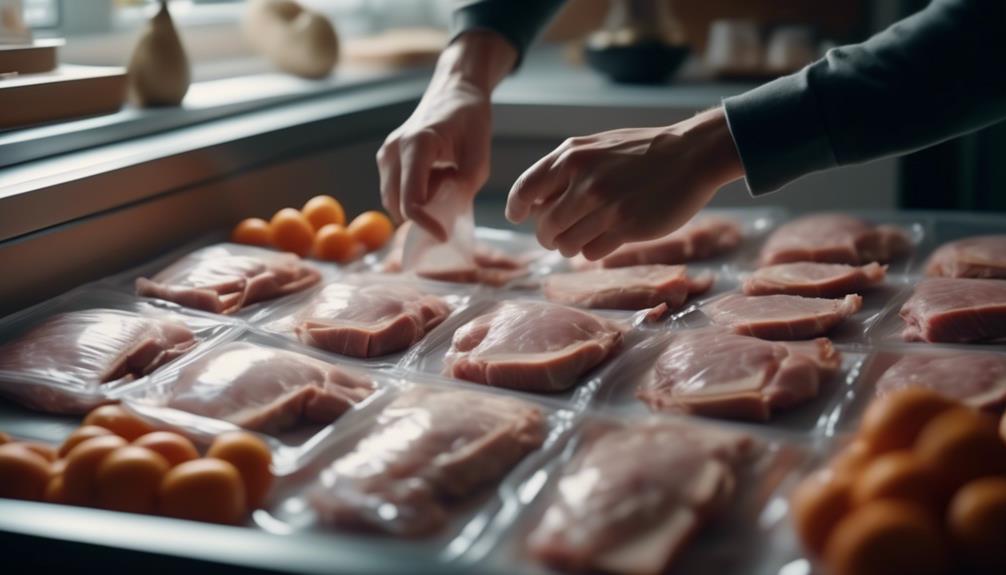Imagine you've just hosted a delightful Thanksgiving dinner, and despite the ravenous appetites at the table, you find yourself staring at a considerable amount of turkey that you'd hate to see go to waste. You know you can't finish it all in the following few days, so freezing becomes the next logical step.
To ensure your leftover turkey remains as succulent as the day it was carved, you'll need to follow a few essential steps. Start by stripping the meat from the bones, cutting it into smaller portions if necessary, to expedite the cooling process and save space in your freezer. You'll want to select the right type of container—airtight is key—to prevent freezer burn and preserve flavor. And don't forget to clearly label each container with the date; you'll thank yourself later when you're trying to remember how long it's been in the freezer.
There are a few more tips and tricks that can help you maintain the quality of your turkey, ensuring it's just as delectable when it's time to thaw and serve again.
Key Takeaways
- Evaluate the quantity and quality of the turkey before freezing
- Wrap the turkey in cling film or aluminum foil before placing it in airtight freezer bags
- Choose containers with airtight seals, such as freezer-safe glass or rigid plastic
- Label each container with the contents and date of freezing for easy organization and rotation
Assessing Your Leftovers
Before you consider freezing your leftover turkey, it's important to evaluate both the quantity and quality of the meat you have on hand. You'll want to ensure that the turkey hasn't been sitting out for too long, as this could affect its safety and flavor when thawed later. Check if the turkey is still moist and hasn't dried out, which is a good indicator of meat quality.
Next, think about portion sizes. It's best to divide your turkey into smaller, meal-sized portions before freezing. This way, you're not forced to thaw more turkey than you need at a later date, which can lead to unnecessary waste. If you've got a mix of white and dark meat, consider separating them as they can be used for different recipes.
When you're packing the turkey for the freezer, remove as much air as possible from the storage bags or containers. This helps to prevent freezer burn, keeping the meat quality intact.
Preparing Turkey for Freezing
Having assessed your leftover turkey, it's time to prepare it properly for freezing to ensure its freshness is preserved for future meals.
Begin with turkey carving, removing the meat from the bones. Slice the breast into thick portions and separate the wings, thighs, and drumsticks. If you've got a large family or enjoy bigger servings, you might leave some pieces whole. Remember, the shape and size of your portions will affect both the freezing and thawing processes.
To maximize moisture retention, which is crucial for keeping your turkey delicious after thawing, consider wrapping the meat in cling film or aluminum foil. Then, place the wrapped turkey in airtight freezer bags. Squeeze out as much air as possible before sealing the bags. This step helps prevent freezer burn and maintains the turkey's texture and flavor.
If you're a stickler for organization, label each bag with the date and contents. This way, you'll know exactly what you have and can manage your frozen inventory effectively.
Now, your turkey is ready to be frozen. Place it in the coldest part of your freezer, and rest assured that your turkey will be just as satisfying when it's time to enjoy it again.
Choosing the Right Containers
Selecting the right containers for your turkey is crucial, as they'll safeguard the quality and taste of your meat during its time in the deep chill of your freezer. You want to ensure your turkey remains as delicious as when it was first carved.
Here's what you need to keep in mind:
- Airtightness: Choose containers with airtight seals to prevent freezer burn and moisture loss. This will keep your turkey succulent.
- Material: Opt for freezer-safe glass or rigid plastic. These materials won't crack at low temperatures and can be reheated if necessary.
- Size: Practice portion control by picking containers that match the amount of turkey you'll likely use per meal. This avoids thawing more than you need.
- Vacuum Sealing: Consider vacuum-sealed bags, which are perfect for maximizing freshness and minimizing space.
The right container not only preserves your turkey but also makes your life easier when it's time to reheat and serve. Remember, portion control helps manage leftovers efficiently, and vacuum sealing is your best bet for locking in flavor. Don't skimp on quality—your future meals will thank you!
Labeling and Date Marking
Once you've secured your turkey in the right containers, it's essential to label them with the contents and date to ensure you're enjoying your leftovers at their best. Proper labeling is a crucial step in your storage methods, as it helps maintain organization and maximizes safety. Without a clear label, you might be left guessing whether your turkey is still good to eat or if it's time to toss it out.
Adopting a rotation strategy in your freezer ensures that older items are used first, preventing waste. Here's a simple table to help you stay organized:
| Content | Date Frozen | Use By |
|---|---|---|
| Turkey Breast | 11/28/2023 | 05/28/2024 |
| Turkey Leg | 11/28/2023 | 05/28/2024 |
| Turkey Gravy | 11/28/2023 | 02/28/2024 |
| Turkey Stuffing | 11/28/2023 | 12/28/2023 |
| Turkey Casserole | 11/28/2023 | 04/28/2024 |
Make sure your labels are clear and legible. You can use freezer-safe labels and a permanent marker to avoid any ink smudging due to the cold and moisture. Remember to include both the date of freezing and a 'use by' date to track freshness. With this approach, you'll always know at a glance what you have on hand and how long you can enjoy it.
Thawing and Reheating Tips
When you're ready to enjoy your frozen turkey leftovers, it's crucial to thaw them properly to maintain both safety and flavor. Safe defrosting is a process you can't rush, but don't worry—it's not complicated. Here's how to do it right:
- Refrigerator Thawing: Transfer your turkey leftovers from the freezer to the fridge. Allow approximately 24 hours for every 4-5 pounds of turkey. This slow thawing ensures the turkey remains at a safe temperature to prevent bacterial growth.
- Cold Water Thawing: If you need a quicker option, use the cold water method. Submerge the turkey in its original airtight packaging in cold water, changing the water every 30 minutes. Count on about 30 minutes per pound for complete thawing.
- Reheating methods: Once thawed, reheat your turkey in the oven or microwave. In the oven, cover the turkey with foil and heat at 325°F until it reaches an internal temperature of 165°F. For microwave reheating, use a microwave-safe dish, cover it, and rotate it for even heating.
- Avoid Counter Thawing: Never thaw turkey on the counter, as the outside can reach a temperature where bacteria thrive well before the inside thaws.
Following these steps ensures you enjoy your turkey safely and deliciously every time.

